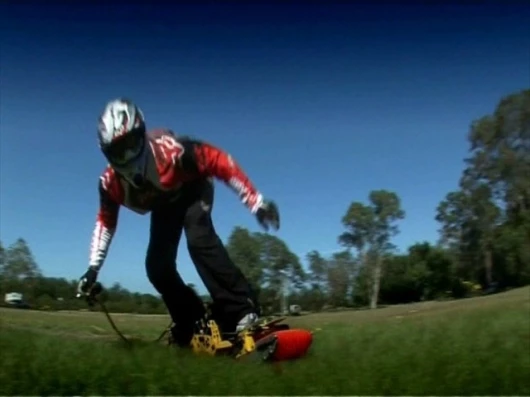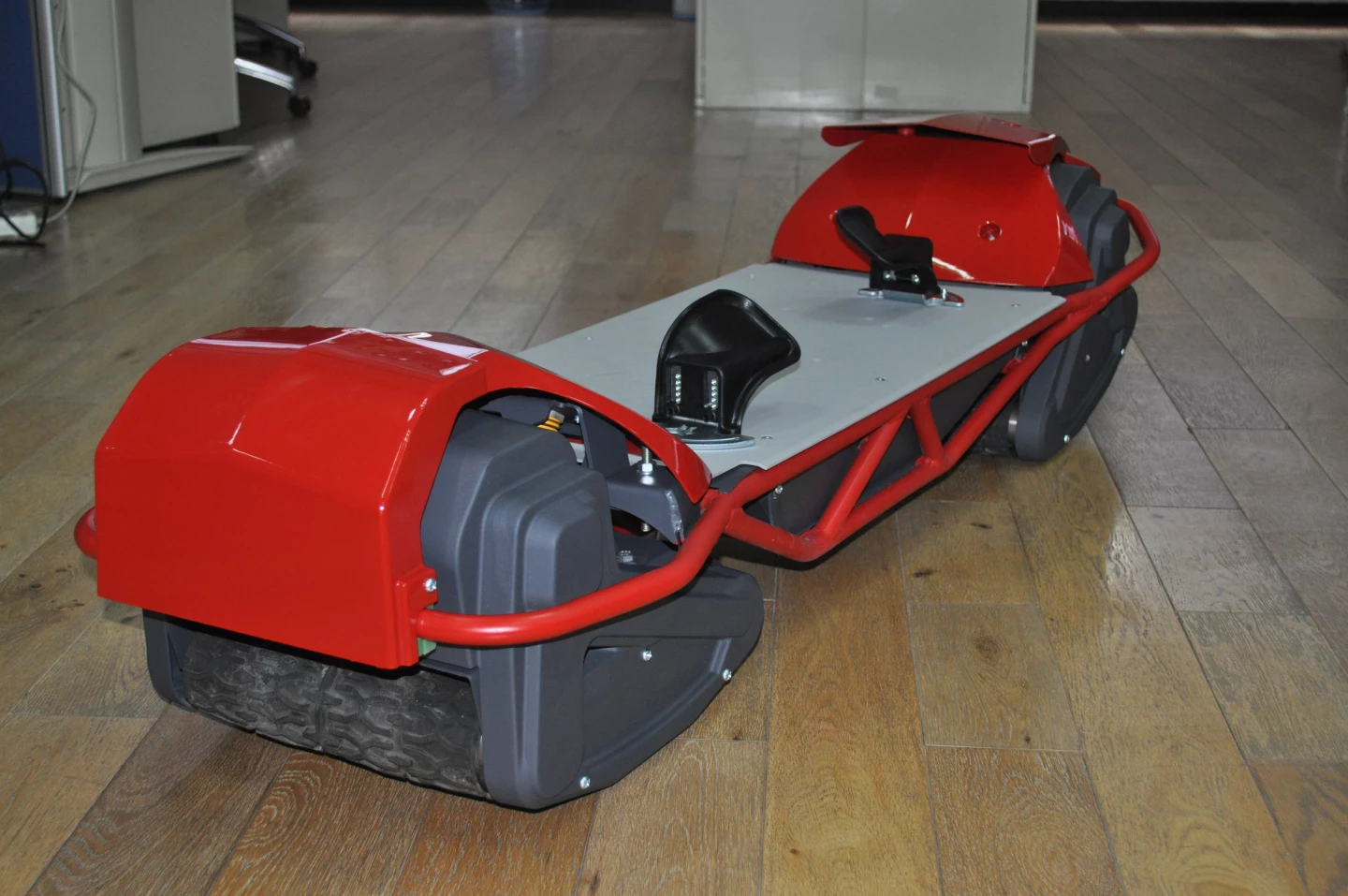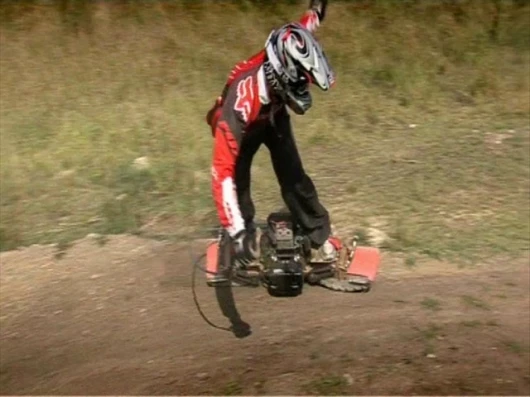Two years ago, we had a look at the Scarpar - a twin-tracked, high speed all terrain powerboard that seemed like a promising power toy. Well, we've just spoken to Scarpar CEO Andrew Fern, who has confirmed that this unique vehicle is going into production later this year, and he's taking deposits as of now. Basically everything on the board has been changed since the last prototype we saw - it now runs an independent electric motor in each of the two articulating tracks, and the hand-held throttle and brake unit is now wireless. And as Fern describes after the jump, getting it to a production-ready point has been a herculean effort; his design team more or less had to create their own realm of engineering theory to deal with such an unprecedented set of vehicle dynamics. The following interview is a fascinating look into the development cycle of a new product. Most importantly though, the Scarpar still looks like extreme fun, and a remarkable way to launch yourself into the foliage.
It seemed like such a simple idea when we first looked at it - a tank-style track at each end of a skateboard, combining the fun steering and carving of a skateboard with all-terrain drive capability and the ability to reach high speeds. The Scarpar is a hard device not to like at first glance.
But CEO Andrew Fern found that consumer enthusiasm doesn't necessarily translate itself into capital in this day and age: "When you've got a device to take to market, venture capital and angel capital are noticeably absent. Everybody's looking for the next Twitter or Facebook or whatever, but if you've got a physical device, it's a pretty tough slog."

So, armed with a small team and a "bootstrap" budget, Fern has taken longer than expected to push the project toward a commercial reality. Based in Queensland, Australia, he engaged aerospace/automotive specialists EDAG as his engineering partners and set them to work on turning the Scarpar prototype into a safe and well thought through product.
But the engineering process proved far from straightforward: "It has been a lot more complex and difficult than even EDAG estimated it could be," says Fern, "I mean, how hard can it be? It's just a board with tracks and a motor, and the tracks articulate. But when you get down to it, OK, what are the losses in the system, and how much torque do you actually need to turn those tracks - and by the way, where are those tracks going to come from? Because they don't exist. So every part has to be made.

"The tracks themselves are a really good example of the engineering challenges. The tracks are basically a one meter continuous loop, the equivalent of a timing belt. But a timing belt is not designed to be bashed from the outside ... We needed the precision of a timing belt, but we needed the ability to take a hit from the outside of something like a snowmobile track ... Now, a snowmobile has no constraints in terms of weight, they have a huge amount of power, so they don't have to build things light. Whereas we're trying to build a track that weighs a couple of kilos, that can run at 50 km/h, and be bashed from the outside, and is still precision enough to make the losses very low so we can actually power the thing... The engineering challenges with making something like this lightweight are really significant."
The heart of the beast
Last time we checked, the Scarpar prototype was running on a 2-stroke petrol engine - but in the process of getting it production ready, this has changed to two electric motors, one in each articulating track.
Why electric? Two main reasons, says Fern. "Two stroke is really the only way to get the power to weight ratio in a combustion engine that we need, and two-strokes are just about illegal in California. Also, there's a lot of pressure on off-road in general to be a bit environmentally sensitive and aware. We think that, going electric straight away, it's hard right now, just because of the issues with battery capacity and those kinds of things. But we think in the long run it'll pay. We're building a company for the future, not something we could've built 25 years ago.
"If things like the nano-silicon stuff that's coming out of Stanford in the last couple of years actually gets into production, you're talking about battery packs that'll have 10 times the capacity of the current stuff. We're using decent lithium phosphate batteries, so they're chemically stable and quite dense, not quite as dense as lithium polymer, but they don't blow up, either... 'Does not blow up' - we'll put that on our spec list."
The other reason is the using electric motors greatly reduces the mechanical complexity - and thus the potential points of failure on the device: "One of the issues we had with the combustion engine was that we had a very complex drive train. Because the tracks were articulating, and we were running from a static crankshaft, we had to have ways of allowing that mechanical power to actually move in an odd pattern. We were using splined shafts, we tried all kinds of things to deliver the minimum amount of losses and maximum reliability.

"Because the motors are mounted on the tracks now, the power is basically direct. Which is awesome for us because the losses in the system have come down significantly. So the losses have come down a lot, and the complexity has come down a lot too. If you'd had a look at the old vehicle and said 'which bit's gonna break' you'd have looked at the drivetrain and said, 'well there's a lot of bits there. There's a lot of things that could go wrong.' So in terms of commercial reliability, in being able to ship it and say we'll give you a one year warranty, that's been a significant step for us."
If the idea of electric power sounds like a bit of a petrolhead turn-off to you, you're not alone. In fact, Fern's chief product tester Darren Powell, who holds the current world speed snowboarding record at 202 km/h (125 mph), was pretty lukewarm on the idea at first too. As fern puts it: "Darren thought 'yeah, the electric motors, they're the things they put in wheelchairs' - but he was quite frightened by it when he first squeezed the trigger and went 'aw shit!' Yeah, it's an unbelievable amount of power. The two motors have about 13 or 14 newton-meters of torque. You have effectively 100% of torque from zero. I reckon there'll be a few people be pretty surprised."

The Scarpar will be far and away the most powerful vehicle of its type on the market. Speaking of the current competition, Fern says, "the best of them have like an 800 watt motor on them, and we're talking 3 kilowatts ... The motors themselves are the size of a coke can and they're just unbelievably powerful."
The new design has achieved a degree of water resistance, too: "The thing is going to be IP55 rated, which means you can bring it home and hose it. You can't go and submarine it, but it's pretty cool to have an electric vehicle that you can bring home and hose off.
"You'd be able to go through something 3-4 inches deep without too many dramas. It's not designed to be a wave board, even though we know some people will try to use it as a wave board. And we've had emails from people who reckon they want to try and aquaplane it. My position on this is that the company does not condone this, however, could you please video it?"
Stopping the Scarpar at speed
Brakes have been another key challenge for the Scarpar engineering team. Most other electrically driven boards effectively use a regenerative braking system, turning the electric motor into a brake - but this has its limits. "The larger kind of motorized mountain boardy kind of electric stuff that's out there, if you went and put those on a 15 degree slope and stood on it, I doubt that they'd stop, based on our experience. So we've had to go again and integrate an electromechanical shaft brake into the system."The whole thing has been entirely engineered from the ground up using automotive standard processes. I mean, everything down to meshing the vehicle so it can be crash tested. There's been a lot of things that have come up where we've decided to make it a powersports product and not a toy. Every single component has had to be considered in detail from an engineering perspective. I think it's fair to say that if we didn't have such capable engineering partners we just wouldn't have got there."
Why limit the Scarpar to 45-50 km/h?
The original thinking behind the Scarpar was that it should be able to do a solid 60kmh - but that changed as production testing got underway: "We've got it speed limited to 45-50 km/h," says Fern, "That's not slow, but you'd be amazed at the number of people that complain and say 'why won't it do 80?' Well, because we don't want you to die. It was really entertaining having this conversation with Darren Powell, who's got the world downhill record for speed snowboarding. I said to him 'whaddya think of 45 kays an hour' - and this is a direct quote, he said, 'It's bloody fast standing up.' And it is!"Perhaps the lead mechanical engineer on the project has the best way of visualizing that sort of speed: " he said, 'you stand on the roof of a car, I'll speed up to 50 km/h, and then you tell me if that feels fast or not!'
"My sounding board for this is Darren. We've probably had it up to 30, 35, and we'll get the rest out of it in production testing in October. But if it's fast enough for him, and he's done 202 on a snowboard, then it's fast enough for everyone else as well! He didn't think speed was going to be an issue at all."

Controlling the Scarpar
With its articulating tracks, steering the Scarpar is the same as steering a skateboard, snowboard, or even a surfboard: simple weight transfer. Lean and go. The throttle and brake, however, are handled by a handheld control device."One really cool thing that we've been able to do as part of the engineering process has been to make the control system wireless," says Fern, "and that's not an insignificant challenge, either, dealing with things like disassociation of the controller, and dealing with all the safety aspects. Interference, where somebody else accelerates for you, that's not a good idea! But we've had the right guys working on this, they're way smarter than me and they've come up with some really good solutions. Everything from the geometry upwards."
Capitalizing on this unique IP
Because the Scarpar development process has pushed out towards the boundaries of existing engineering knowledge, the EDAG team have come up with some pretty unique solutions."We're dealing with an unknown system," says Fern, "EDAG has had to go and develop a lot of engineering theory. If you go and try to find a lot of engineering data about a 1.5 meter long vehicle with a driven front track at one angle and a driven rear track at another angle that are both spinning at up to 3000 RPM, well there isn't one. What castering effect, for example, will there be? All this kind of theory doesn't really exist for an angled track."
But now that those challenges are solved, there could be any number of opportunities for this small company once the consumer product is out and rolling, and some income is there to free up resources: "One of the long term opportunities for us is military. We've had conversations with a few companies about partnering in that space - but we're flat out resource-wise just getting a consumer product to market. But if you think about this in terms of a remote deployment platform, or a reconnaissance platform where it can go over just about any surface at just about any speed ... It's not incapable of going significantly faster than 50kmh (31 mph), we just have it governed for compliance and safety reasons. So the capability of it to do a bunch of things as a remote deployment platform is significant.
"There's 6 or 8 companies at the moment making these kind of deployment vehicles, but they're all low-speed, and that's where we may have quite an interesting solution, because the speed is not an issue."
The path to market
After a lot of "hard slog," the Scarpar is on its final approach to consumer availability. Darren Powell and other official testers will be doing their final pre-production testing in September, and limited demo rides are expected to start in October, which will likely be the first time that people who have put in deposits for these things will get a chance to see the technology in action and have a ride themselves.The first Scarpar board will ship to pre-purchase customers in December this year, and serial production is slated to begin in March 2012. Interest from distributors has been very encouraging; Fern says "We've probably had about 80 distribution approaches I guess, so it's been pretty crazy."
Initial pricing would appear to be US$2,799 for the 1.5 kW model capable of 18 mph (30 km/h), and US$3,799 for the 3.0kW model capable of 28 mph (45 km/h).
We wish Andrew Fern and Scarpar all the best and look forward to seeing this thing hit the market. With this kind of speed and power, the timid need not apply. More information at the Scarpar website.











